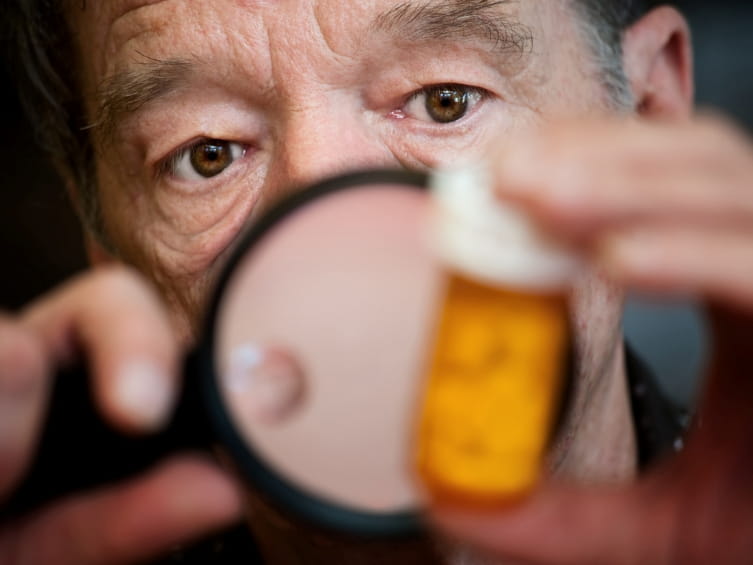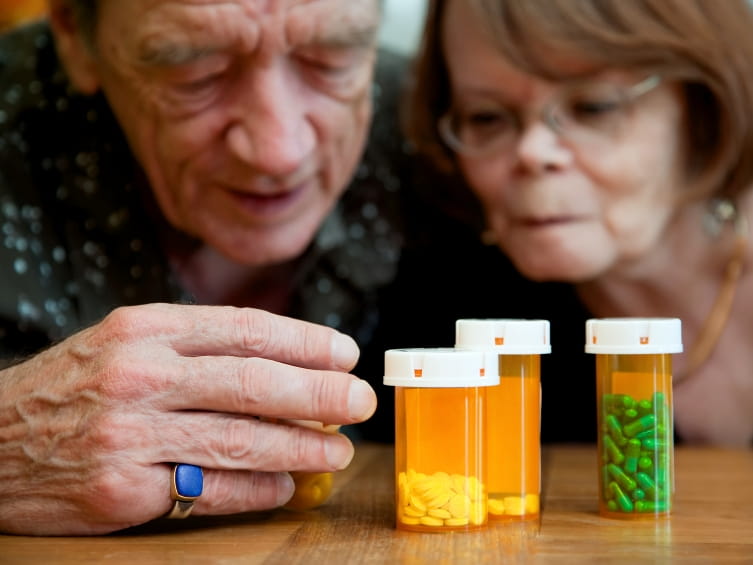Medications Can Get Confusing!

The Bottom Line
Many calls to Poison Control are from older adults who get their medications confused. This is always cause for alarm. Sometimes it's dangerous.

The Full Story
Many Poison Control calls are from older adults who get their medications confused. This is always cause for alarm. Sometimes it's dangerous. Here are some frequent examples:
- Taking an extra dose because you forgot that you took your medicine already.
- Taking two medicines with the same active ingredient, for example two kinds of cough and cold medicine.
- Taking the wrong kind of insulin.
- Putting all the pills in one container, then not remembering if the blue one was for blood pressure or arthritis.
- Forgetting to take your medicine.
We're fortunate that medicines help us live long, productive lives. But, it can be terrifying to be dizzy because you took a double dose. It can be expensive to spend a day in the hospital because you took the wrong medicine. And no one wants to forget his or her medicine and become ill as a result.
There are solutions, but the best solution for one person might not work for another. Work with your health care provider, pharmacist, and/or your family members to find the medication management technique that's best for you. Here are a few examples:
- A medication minder has compartments for day of week and time of day. There are many sizes available. These can be set up once a week. All during the week, a quick glance will tell you if you took your pills with breakfast or forgot your pills in the evening. (If young children spend time in your home, be sure this container is child-resistant. Store it where children cannot get to it.)
- A written log can be set up ahead of time or written in as you take your medicines. Either way, you can tell at a glance if you've taken your medicines.
- If you forget to take medicine, an alarm or buzzer could work to remind you.
Whether filling a minder, taking medicine from a container, or measuring insulin, basic safety techniques apply:
- Take only your own medicine.
- Check the label every time you take medicine. Take the right medicine at the right time in the right amount.
- If you need glasses, wear them.
- Turn on the light!
If you think you've made a mistake with your medicine, use the webPOISONCONTROL® online tool for guidance or call Poison Control at 1-800-222-1222 to find out what treatment might be needed. Expert help, online and by phone, is available 24 hours a day.
Rose Ann Gould Soloway, RN, BSN, MSEd, DABAT emerita
Clinical Toxicologist
Poisoned?
Call 1-800-222-1222 or
Prevention Tips
Whether filling a minder, taking medicine from a container, or measuring insulin, basic safety techniques apply:
- Take only your own medicine.
- Check the label every time you take medicine. Take the right medicine at the right time in the right amount.
- If you need glasses, wear them.
- Turn on the light!
This Really Happened
Case 1: A 35-year-old man took his normal dose of Lantus® (a long-acting insulin with a duration of up to 24 hours) at 8:00 PM. He forgot that he had taken it and repeated the same dose of insulin at 10:30 PM. His blood glucose at home was 29 mg/dL (milligrams per deciliter; normal random blood glucose is 70-125). He tried to treat himself by eating food but this brought his blood glucose up only to 55. He felt ill and sweaty and called 911. The paramedics immediately gave him intravenous (IV) dextrose 50%. His blood glucose rose to 250. Four hours after the insulin error the emergency physician consulted Poison Control. The patient's blood glucose was running in the 190s to 200s with food and IV dextrose. Poison Control advised 24-hour admission with frequent blood glucose monitoring due to the long-acting nature of Lantus® insulin and the potential that the patient's blood glucose could still drop dramatically even with food and dextrose.
Case 2: A 68-year-old woman was newly prescribed Norvasc® (a drug used to treat high blood pressure among other conditions) 10 mg by mouth daily. However, she mistook the Norvasc® bottle for her hydrocodone (a narcotic pain reliever) bottle since they looked alike. The patient took two Norvasc® 10 mg tablets twice a day for 2 days. She called Poison Control complaining of a pounding headache and dizziness. The usual maximum daily recommended dose of Norvasc® is 10 mg. At the time the patient called Poison Control, she had taken 40 mg within 8 hours. Poison Control recommended ambulance transport to the nearest emergency room right away due to the potential for this drug to cause low blood pressure (BP) and heart rate, and heart block.
References
DeSevo G, Klootwyk J. Pharmacologic Issues in Management of Chronic Disease. Prim Care Clin Office. 2012;39:345–362. Doi:10.1016/j.pop.2012.03.007.
Poisoned?
Call 1-800-222-1222 or
Prevention Tips
Whether filling a minder, taking medicine from a container, or measuring insulin, basic safety techniques apply:
- Take only your own medicine.
- Check the label every time you take medicine. Take the right medicine at the right time in the right amount.
- If you need glasses, wear them.
- Turn on the light!
This Really Happened
Case 1: A 35-year-old man took his normal dose of Lantus® (a long-acting insulin with a duration of up to 24 hours) at 8:00 PM. He forgot that he had taken it and repeated the same dose of insulin at 10:30 PM. His blood glucose at home was 29 mg/dL (milligrams per deciliter; normal random blood glucose is 70-125). He tried to treat himself by eating food but this brought his blood glucose up only to 55. He felt ill and sweaty and called 911. The paramedics immediately gave him intravenous (IV) dextrose 50%. His blood glucose rose to 250. Four hours after the insulin error the emergency physician consulted Poison Control. The patient's blood glucose was running in the 190s to 200s with food and IV dextrose. Poison Control advised 24-hour admission with frequent blood glucose monitoring due to the long-acting nature of Lantus® insulin and the potential that the patient's blood glucose could still drop dramatically even with food and dextrose.
Case 2: A 68-year-old woman was newly prescribed Norvasc® (a drug used to treat high blood pressure among other conditions) 10 mg by mouth daily. However, she mistook the Norvasc® bottle for her hydrocodone (a narcotic pain reliever) bottle since they looked alike. The patient took two Norvasc® 10 mg tablets twice a day for 2 days. She called Poison Control complaining of a pounding headache and dizziness. The usual maximum daily recommended dose of Norvasc® is 10 mg. At the time the patient called Poison Control, she had taken 40 mg within 8 hours. Poison Control recommended ambulance transport to the nearest emergency room right away due to the potential for this drug to cause low blood pressure (BP) and heart rate, and heart block.
